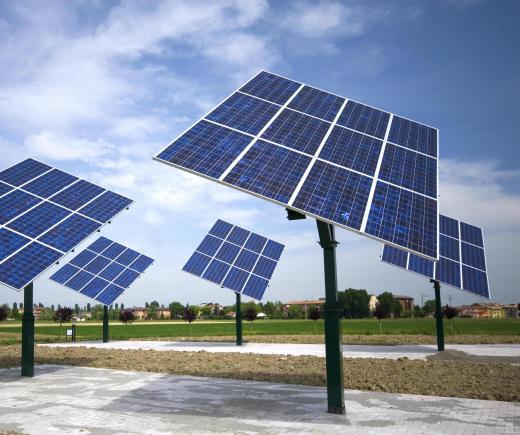What are Angles of Insolation?
 Mary McMahon
Mary McMahon
Angles of insolation measure how high the sun is in the sky in relationship to the location of the viewer. Insolation is a contraction of three words, incoming solar radiation, and should not be confused with insulation, which has a u instead of an o. Incoming solar radiation takes two forms that are directly observable by humans — light and heat — and everyone has observed the factor of angles of insolation at work when they track the sun across the sky from sunrise to evening or move down the beach for better sun. These angles vary depending on where on Earth the studier is standing and what time of day and year it is.
The angle of the sun has a major effect on climate and is therefore of immense interest to climatologists and meteorologists. Agriculture, architecture, health, and energy generation are among the many fields in which angles of insolation are taken into account and accounted for, especially in climates to the extreme North and South of the globe, where the angles are small, meaning that the sun's energy is poorly concentrated and must be maximized. Several factors combine to form angles of insolation. The first is the location of the Earth's orbit, because as the Earth rotates around the sun, the angle of the planet changes, exposing the Northern and Southern hemispheres alternately to the most direct angle of the sun's rays. Another important factor is the time of day, because as we rotate away from the sun and into the darkness, the angle grows smaller.

Angles of insolation range from 0° to 90°, with the most intense being at 90°, when the sun is directly overhead, and the weakest at 0°. The angles are only observable during daylight, since at night there is, of course, no solar radiation. At dawn and dusk, the angle is very close to 0° and the sun's energy is very weak. As the sun moves through the day, the angle grows higher until noon, at which point it begins to decline again.

The angles are taken into account by architects designing buildings who wish to maximize their solar energy by, for example, increasing the amount of windows on the equator-facing side of the building. Farmers and others dependent upon the sun's energy for sustenance are also acutely aware of angles of insolation, and they plan out their fields and orchards accordingly. They are also taken into account in Northern Europe, where prolonged darkness accounts for a very high suicide rate in the winter, and measures are taken to counteract the effects of seasonal depression. Naturally, energy companies using solar power also map out and adjust their solar panels to take the most advantage of insolation.
AS FEATURED ON:
AS FEATURED ON:














Discussion Comments
One way that I use in my classroom is the Tan-1 method. Place a meter stick at a right angle to the ground, and measure the length of the shadow cast on the ground using another meter stick. Then, divide the length of the meter stick (100 cm; 1 m; 1,000 mm...etc) by the length of the shadow (using the same units). Then, using the decimal number, input into calculator using tan-1 function, making sure calculator is in degree mode. That will give you the angle of insolation.
How do you calculate it?
Post your comments